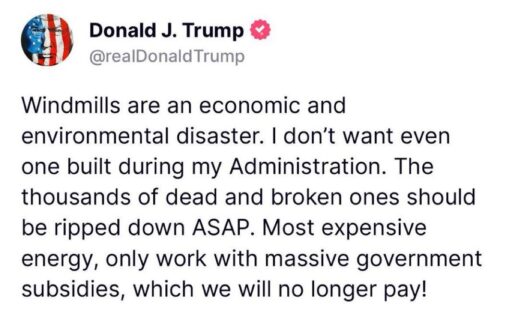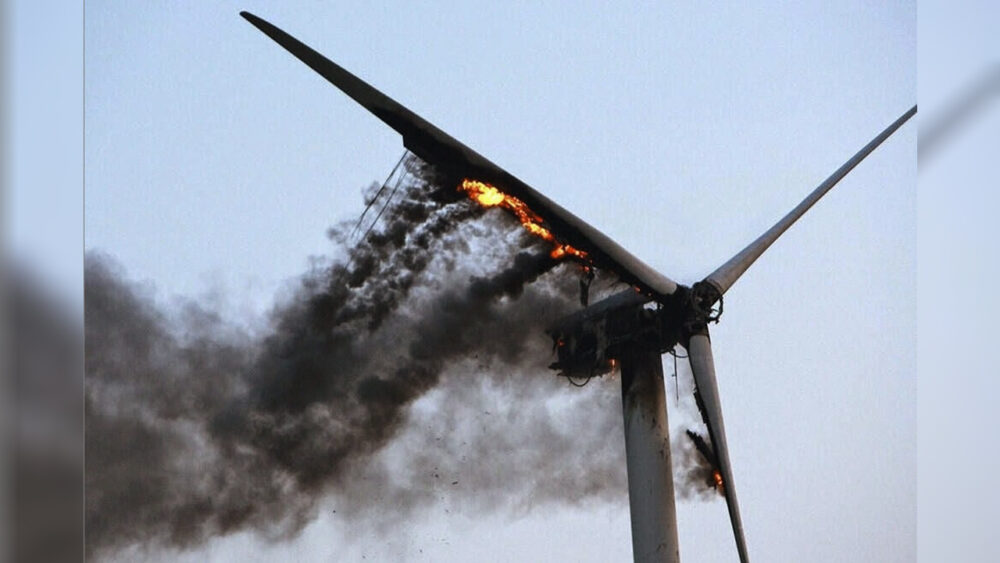President Trump’s declaration on January 15, 2025, that no new wind turbines will be built under his administration and that existing ones should be dismantled, was not rhetorical bluster. It was a long-overdue recognition of wind energy’s central contradiction: its green image masks an environmentally destructive, economically unsound, and technologically brittle reality. His administration’s immediate actions, including the revocation of offshore wind leases and the freeze on onshore wind permits, have reoriented federal energy policy around a single principle: energy must be reliable, economical, and genuinely sustainable. Wind energy fails on all counts.

The mythology of wind as a clean, renewable panacea has been driven more by ideology than evidence. Manufacturing a single wind turbine requires hundreds of tons of concrete and steel, mined, transported, and forged through carbon-intensive processes. The Danish Environmental Protection Agency notes that emissions from producing one offshore wind turbine often exceed 241 tons of CO2, with most of that emitted before the turbine ever spins. These turbines also contain rare earth metals like neodymium, whose extraction in Chinese mines is linked to radioactive wastewater, deforestation, and toxic tailings that leach into rivers. This is green energy in name only.
Moreover, the ecological toll extends beyond production. Wind farms kill an estimated 573,000 birds annually, including thousands of golden eagles and other raptors, according to a study published in the Wildlife Society Bulletin. The US Fish and Wildlife Service has even issued “eagle take” permits to allow wind operators to kill protected birds in exchange for conservation offsets, a bureaucratic sleight of hand that would be condemned in any other industry. California condors, among the rarest birds on the continent, now fly near turbine blades that will, in the words of one federal official, inevitably strike them. The fact that wind developers are now funding condor breeding programs to compensate for future deaths is not a solution, it is an admission of guilt.
Offshore wind is no better. The surge in whale strandings along the Atlantic coast, seven whales in 39 days in New Jersey alone, has sparked public outrage and concern among marine scientists. While definitive causation is complex, the noise from sonar mapping, pile driving, and increased vessel traffic associated with wind farm construction are leading suspects. The North Atlantic right whale, already teetering on the brink of extinction, cannot endure this industrial intrusion into its migratory corridor. As President Trump succinctly put it, the windmills are driving the whales crazy.
The foundational problem of wind energy, however, is not merely its ecological damage but its unreliability. Wind is an intermittent resource, often unavailable when demand peaks. Texas learned this lesson brutally in February 2021, when wind generation collapsed during a cold snap, contributing to grid failure and blackouts. The North American Electric Reliability Corporation (NERC) has since warned that the growing share of wind and solar power is making the grid less stable, not more. Unlike gas or nuclear plants, wind turbines cannot be dispatched on demand. They require fossil-fuel backups that must ramp up or down inefficiently to match fluctuations, a system so fragile that it introduces carbon emissions precisely where reductions are promised.
Indeed, wind’s inefficiency undermines its climate rationale. A comprehensive analysis in Denmark, long hailed as a wind power pioneer, found that despite wind generating about 25 percent of electricity, national carbon emissions declined by only 4 percent. In Colorado, integration of wind caused emissions to rise due to coal plants cycling inefficiently. This is not decarbonization, it is performance theater.
Wind energy also imposes immense costs on landscapes and communities. A nuclear reactor can produce more energy on 1,000 acres than a wind farm can on 200,000. The Breakthrough Institute estimates wind’s median land-use intensity at 12,000 hectares per terawatt-hour, compared to just 7 hectares for nuclear power. The result is a sprawling industrial footprint that fragments habitats, scars scenic vistas, and invites public backlash. In Ohio and Indiana, counties have passed ten-year moratoria on new wind projects. In California, desert ecosystems are bulldozed to make way for turbines. Residents speak of low-frequency noise that disturbs sleep and shadow flicker that devalues homes. Infrasound from large turbines can travel miles, disrupting both wildlife and human health. This is not NIMBYism, it is rational resistance.
Nor can the grid integrate wind energy without incurring massive infrastructure costs. Because wind power fluctuates, grid operators must build expensive battery farms or keep backup fossil plants online. NERC’s 2022 report makes clear: batteries are not enough. We need backup fuel. And that means building out natural gas infrastructure alongside wind, negating both environmental and economic claims. Moreover, long-distance transmission lines are required to bring wind from remote plains to population centers. These lines face the same local opposition as the turbines themselves, making both slow and expensive.
Most damning of all, wind energy remains entirely dependent on government subsidies. Despite accounting for just 10 percent of US electricity, it has absorbed over half of all federal energy subsidies. Without the Production Tax Credit and state-level incentives, the entire industry would collapse under its own weight. President Trump’s decision to end these subsidies marks a return to fiscal sanity. Subsidizing failure is not innovation, it is stagnation.
By contrast, nuclear power offers a genuinely clean, dispatchable, low-carbon solution. Small modular reactors now under development promise greater safety, lower costs, and faster deployment. They do not kill birds, require little land, and emit zero carbon during operation. Clean natural gas, too, serves as a pragmatic bridge fuel, abundant, affordable, and far less damaging than the chaos of wind.
The Trump administration’s wind moratorium is not merely a political gesture, it is a policy correction. On January 20, 2025, the president withdrew all federal offshore lands from wind leasing. Onshore projects were halted pending environmental review. Public remarks reinforced the shift. At a June 2025 event, Trump called wind farms horrible, ugly structures that kill birds and ruin landscapes. His words, often dismissed by critics, reflect an underlying truth: wind energy has failed to live up to its promise.
This failure is now the subject of legal confrontation. On May 5, 2025, eighteen states and the District of Columbia sued the administration over its wind moratorium. They argue that stopping offshore wind development harms jobs and clean energy goals. Yet these goals cannot justify environmental degradation, grid instability, and wasteful spending. The lawsuit reveals a deeper divide: between those who chase a utopian energy vision, and those who prioritize results.
Energy policy must be based not on slogans, but on science and stewardship. The steelman case against wind is this: it is dirty to build, deadly to wildlife, intermittent in delivery, costly to integrate, and unpopular on the ground. Better options exist. Nuclear and natural gas deliver reliability and emissions reductions without covering the landscape in 500-foot turbines. Solar power, sited smartly, can supplement these sources without the bird carnage or grid havoc.
Let us then turn away from the green mirage. America does not need wind power to meet its energy future. It needs rational planning, proven technology, and the courage to admit when an experiment has failed. The wind industry may keep spinning, but it is time for federal policy to stand still and say no more.
If you enjoy my work, please consider subscribing https://x.com/amuse.


